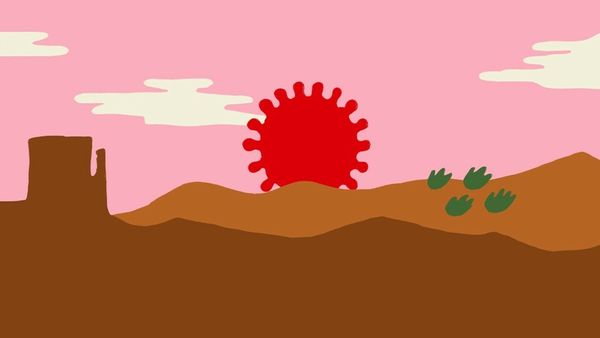With most pandemic restrictions a thing of the past and isolation periods shortening, Australians are enjoying lives as close to pre-COVID times as they have since early 2020.
Nationally the COVID isolation period has changed from seven days to five, and this week Queensland, New South Wales and South Australia have all announced they would no longer require masks to be worn on public transport.
Internationally, there is growing hope of a light at the end of the tunnel.
The World Health Organization has said that while the pandemic is not over, "the end is in sight". US President Joe Biden went a step further, declaring the end of the pandemic over at the weekend in an interview with CBS's 60 Minutes program.
But experts are split on whether Australia is at the beginning of the end.
Is the worst of the pandemic behind us?
University of Melbourne epidemiologist Professor Tony Blakely told the ABC News Daily podcast there was a high chance we had seen the worst of the virus.
"The frequency with which we're seeing new variants come up is looking like it's starting to slow down," he said.
That leads him to conclude Mr Biden is probably right in declaring the pandemic to be over.
"I'm pretty confident, 90 per cent confident, that the worst of the pandemic is behind us," he said.
Professor Blakely pointed to the fact that about 60 per cent of the world's population had now received two doses of a vaccine as a good sign that we are getting on top of the virus.
He estimated one in two people around the world had now had COVID-19, meaning natural immunity was also growing globally.
"The immunity from natural infection is better at stopping transmission … and seems to wane less, particularly for younger people," Professor Blakely said.
"All those things put us into a position where we're more resilient no matter what the virus throws at us."
'Peaks and troughs' still to come
At the weekend, Victoria's Chief Health Officer Brett Sutton wrote on Twitter that "peaks and troughs" of the virus and its variants would continue.
Professor Sutton, who became one of the country's most recognisable faces at the height of the pandemic, said it was clear COVID was in a "trough" phase, with fewer cases and hospitalisations.
However, he warned a new "lower and slower" wave could come before the end of the year.
"Most previous waves have been driven predominantly by new variants of concern," he wrote.
"The coming 'wave' — if that's the term — may be driven more by waning hybrid immunity (recent infection + vaccination) than by any particular variant."
"Make no mistake, the variants will come," Professor Sutton continued, singling out two subvariants — BA.2.75, which was first detected in India in early May, and BA.4.6, a newer subvariant which has been gaining traction in the US — noting they were not "strongly outcompeting" the current variants of concern BA.4 and B.A5.
Data from the federal department of health confirmed several hundred cases of the BA.4.6 and BA.2.75 variants had already been detected in Australia.
Catherine Bennett, chair of epidemiology at Deakin University, said in places where BA.2.75 was spreading overseas, there had not been a change in hospitalisation numbers.
She said BA.4.6 was one to watch due to its increasing spread overseas — data from the US Centers for Disease Control and Prevention shows it has emerged as the second most prevalent strain behind BA.5 in recent months — although it too was not leading to an increase in hospitalisations, Professor Bennett said.
"The northern [hemisphere] winter over the next few months is a bit of a litmus test for the world in terms of what these sub-variants that are out there already might do, but also what might lie ahead," she said.
New vaccines on the way
Menno van Zelm, professor of immunology at Monash University, said the bivalent vaccines — the first of which was approved in Australia last week — could help tackle new strains as they seemed to be more effective than the vaccines currently being rolled out in Australia.
He said regardless of the type of vaccine, the risk of infection increases about a month after receiving a vaccine or being infected with COVID.
"But by having had your vaccine the risk of severe disease will remain very low," he said.
He also stressed the importance of taking care around vulnerable groups.
"I know we're all tired of the pandemic and tired of the measures, but I do think in those settings where we have people at risk, that we distance and we make sure we limit the spread, so that we limit people getting severe disease," he said.
Population immunity improving
Jodie McVernon, professor and director of epidemiology at the Doherty Institute, said evidence indicated the population was building up decent immunity to the virus.
"That last wave, we believe, was substantially damped by the established immunity of the population," she said.
She said experts were still trying to figure out how best to utilise vaccines to combat waves and new variants, but she predicted Australians may need recurring annual COVID boosters.
Professor McVernon agreed with assessments that emerging sub-variants were not yet outperforming other variants of concern.
"We know that we're going to continue to see evolution of the virus but whether or not those variants are likely to be problematic depends really on how they perform in population," she said.
When will we know the pandemic is over?
Professor Blakely says it's difficult to know exactly when COVID-19 will no longer be classified as a pandemic.
"Declaring when a pandemic's over is a damn sight easier to do in 10 years from now, because we simply don't know what tomorrow is going to throw at us," he said.
"I can't rule out that black swan event whereby suddenly a Delta-like variant throws at us, something that's not only more infectious but more virulent."










